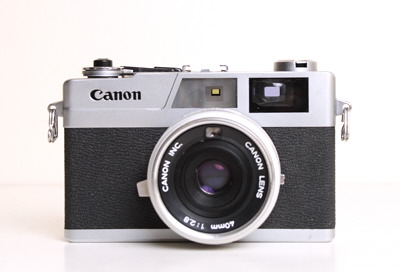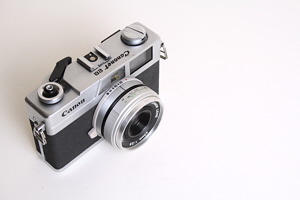3106.photography
Created 7 July 2007 ... Updated 12 May 2009
|
Canon Canonet 28 (new version)
|
|||||||||||||||||||||||||||||||||||||||||||||||||||||||||||||||||||||||||||||||||||||
 After the excellent and highly regarded Canonet QL17, Canon developed a new camera, the Canonet 28. As oposed to the QL17, the 28 was a low end model so it does not have the built quality of the QL17. The 28 featured automatic exposure by setting the shutter speed automatically after the aperture was set, the current shutter speed is shown by a superimposed needle in the viewfinder. The lens is a fixed 40mm f/2.8 lens which is reportedly very sharp with high contrast. Because of the large bright viewfinder, the coupled range finder is very easy to use. Weighing over half a kilo, the camera is not a lightweight but its handling is good, well, for me at least. As I do have large hands and operating a small, light weight plastic camera is often a nuisance so I'm more the all-metal-camera kind of guy :o)
After the excellent and highly regarded Canonet QL17, Canon developed a new camera, the Canonet 28. As oposed to the QL17, the 28 was a low end model so it does not have the built quality of the QL17. The 28 featured automatic exposure by setting the shutter speed automatically after the aperture was set, the current shutter speed is shown by a superimposed needle in the viewfinder. The lens is a fixed 40mm f/2.8 lens which is reportedly very sharp with high contrast. Because of the large bright viewfinder, the coupled range finder is very easy to use. Weighing over half a kilo, the camera is not a lightweight but its handling is good, well, for me at least. As I do have large hands and operating a small, light weight plastic camera is often a nuisance so I'm more the all-metal-camera kind of guy :o)
There are actually 2 version of the Canonet 28, the standard version which was marketed from December 1968 and had the exposure metering cells all around the lens, in Olympus Pen EE style. The "New Canonet 28" had a single CdS cell in the lens, just over the front element. To add to the confusion, both types were named exactly the same but looked entirely different. Being marketed as "camera for the masses", these "new Canonet 28" cameras are plenty and a little under valued, especially compared to the much higher rated G-III and QL17. One of the reasons will be the need for the obsolete 1.35 Volt mercury battery but this problem can be solved by using a cheap hearing aid battery or a, reportedly working, 1.5 Volt mecury battery replacement. Apparently the built quality is also not very high, well, I've only seen 2 Canonet 28s in my life, one belonging to me now which is a wreck, and the other seemed too expensive and also didn't look to fresh anymore. But two is only a very tiny sample so it's hard to say anything definite. You might be lucky and get one in perfectly working order for not a lot of money. When it works, you might have gotten yourself a perfect inconspicuous street camera, it at least seems to have the right prerequisites. The one I got is like new, no corrosion in the battery chamber or anything. The shutter sounded fine, the dials and knobs moved smoothly and after inserting a fresh battery the camera came instantly back to life. If only I could find some time to test it thoroughly... Until then I'll concentrate on the A35F, which actually looks nicer and appears the better camera in my opinion. Note that these cameras suffer from gooey light seals so better get your kit from someone like "Interslice" and repair it before you shoot your first film only to find out afterwards the light traps are shot. The Canonet 28 was followed by the Canon A35F, which was the last of the series of range finders. The onset of autofocus and plastic cameras that followed, definitely took the place in the market away from high quality sturdy metal cameras. Of course, most consumers were, and still are, looking for cheaper, everything-auto cameras. Using a replacement battery (alkaline type 635) reportedly works for negative film. The exposure will often be a little off but still within the limit of negative film. You might also want to try slide film in the camera but depending on the state of the battery, exposure may be off and it might show. So better be careful and run a test film before taking this camera as your only camera on a once-in-a-lifetime holiday. Warning: When light falls on the CdS cell, the exposure metering system is active and slowly draining the battery. So it's advisable to either store the camera with the lens cap on the lens and/or in a dark place and/or with the batteries taken out. Latter is a good idea anyway, there are incountable cameras with dirty/destroyed battery compartments due to forgotten batteries that started leaking. |
|||||||||||||||||||||||||||||||||||||||||||||||||||||||||||||||||||||||||||||||||||||
Specifications
|
|||||||||||||||||||||||||||||||||||||||||||||||||||||||||||||||||||||||||||||||||||||

|
|||||||||||||||||||||||||||||||||||||||||||||||||||||||||||||||||||||||||||||||||||||
All photos copyright of M. Koning 1997 - 2009
Note: Using the text or images on this site in an auction such as eBay without permission is a violation of your ebay Terms of Service. I will report you to ebay if I discover such a violation taking place. This may result in your account being cancelled. I also reserve the right to file claim for civil penalties.
Return